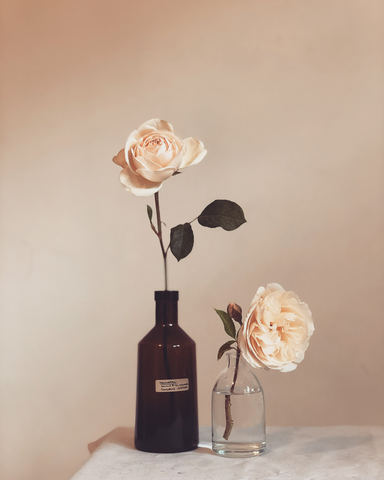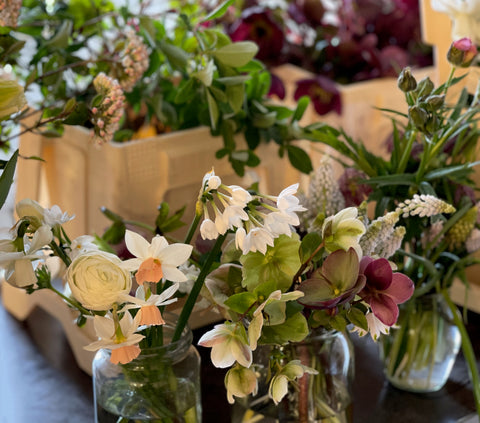Flowers can be so much more than pretty. They can transform spaces.

Flowers are used to celebrate, to mark transitions and to offer comfort, they are created to share beauty and to show that you care. It was a stroke of genius by Shane Connolly to use 20 foot trees to line the aisle of Westminster Cathedral for Kate & Will's wedding, they transformed the feeling of the whole building, and this for me, is the greatest power that we as florists have - the ability to affect the way that people feel.
We grow some incredible flowers in this country
Before I began working in this industry, I had no idea that the vast majority of cut flowers for sale here in the UK are imported. As I started to meet other florists who favoured natural floral styles, I started to hear about British flower growers, one by one at first, and then in droves as I began to build a network of suppliers. I found an organisation called 'Flowers from the Farm' and discovered that there are thousands of flower growers in the UK growing incredible flowers.
 Jess of Featherstone's English Flower Co.
Jess of Featherstone's English Flower Co.
Learning to work with British Flowers and growers
We are so often asked about working with British flowers that we've written an entire course about it in collaboration with fantastic professional flower growers Jess & Katie at Featherstone's English Flower Co. It's a course that answers the questions we are asked, and gives you the skills needed to work confidently with British flowers throughout the year. It's the course I wish had existed when I first started taking homegrown flowers seriously. More on that later.
As someone whose business is so rooted in sustainability, I'm probably expected to be judgemental about how other florists work, but that couldn't be further from the truth. As with anything we teach at the flower school, I don't expect people to go cold turkey. In fact, we don't recommend it, and our attendees may never use exclusively British flowers, or entirely foam free mechanics. My hope is that by showing what can be done, we might empower those who are open to change. This shouldn't be "us and them", as florists we're all trying to make a living in an industry that at it's very heart is a celebration of nature.

harvesting flowers at The Real Flower Company, Hampshire
Alongside wanting to know about the sustainability of the flowers we use, I have always been interested in knowing who was planting, tending, harvesting, and packing the flowers I buy; I found that by building relationships with growers I could ask those questions, and even walk the fields of their farms. I know the provenance of every bloom or branch, that the staff have been paid fairly, and neither the ground nor the people involved in the producing these flowers have been exposed to toxic chemicals in any part of the process from seed to harvest and that’s important to me.
Personal ethics aside, there are many other benefits to using British flowers. To start, flowers which don’t transport easily suddenly become a possibility. Flowers like sweet peas, dahlia, and verbascum are not happy out of water for any length of time, but as they are picked freshly by a grower ready for us to collect, we can use them in wedding & event work and in our flower school.

To ensure that flowers last long enough to be transported to Dutch auction houses from the country they started off in, and then on to the UK, breeders have, understandably valued longevity more highly than fragrance, and factored in ease of transport too, with straight stems being easier to pack into boxes, and choosing hardier flowers that last best makes sense. The downside is that some of nature’s most interesting traits have been side-lined. The fragility, nuance and fragrance of flowers is what made me fall in love with them and those are traits I wouldn’t want to live without.
One of the difficulties I initially had to overcome when using British flowers was buying in large quantities. It hasn’t always been easy to get as many stems as I’ve needed for say, a large wedding or an event, but over time things have got easier. I’ve built up a fantastic network of suppliers and I now know who to ask for the best flowers in the right colours that will be picked at the right stage and in the right colour palette. It can be done, even for weddings with large scale installations, and hundreds of guests.

an arch made on a shoot/installation class at Losely Park, Surrey with Mad Lilies Flower Shop
Working with fresh produce can be challenging. Across the UK, flower farmers are germinating seed, looking after corms, planting bulbs and staking plants all year round to supply us with flowers. They are at the mercy of unpredictable weather (that’s been made even more eccentric by global warming) as well as having their defences tested by mice, voles, and even deer all happy enough to burrow under, squeeze through or jump fencing for a tasty snack.
All of this happens before we’ve even got a single stem in our hands!
It’s little wonder that flowers aren’t cheap
So much knowledge and work goes into producing them. It’s easy to think of flowers as a cheap commodity given the prices we see in supermarkets, but the reality is that supermarkets often sell flowers at a loss, they draw customers in and make the place pretty. The price the consumer sees doesn't usually reflect the true cost of producing flowers, even when they are British grown.
Finally, once we do have these precious flowers in our hands it’s up to us to make sure that each stem is conditioned according to its needs. There are flowers with sap that need conditioning away from other flowers, some that need to be dipped in boiling water, some have woody stems that need to be cut up the stem instead of just across at an angle, and others that last far longer if the ends have been scorched by flame. The flowers then need to be allowed to rest overnight before we can begin working with them safe in the knowledge that they are hydrated, and going to be at their very best for every design we (and our flower school students) create. Knowing how to work with flowers takes skill and training.
You might just find yourself wishing you had discovered the joy of British flowers sooner.

As professional florists we know that trusting new suppliers is a big ask, and that it can be hard work changing processes, but what we also know is how rewarding using these flowers can be. How liberating and how exciting too. To find out more about our course British Flowers and How to Work with Them with Featherstone's English Flower Co. click here.
You'll find details, dates and prices for this 8 day course for professional florists & floristry students which covers sourcing, pricing, ordering, and creating designs using sustainable mechanics throughout the year. You can choose whether to attend one season (each season is taught over two days), or sign up for the full course that takes you through a whole year of British flowers starting this May. We'll be cutting flowers from their 3 acre flower farm, conditioning every stem and then creating floral designs in their incredible barn and I can't wait!

If you’ve been inspired to find flower growers near you www.flowersfromthefarm.co.uk is a great place to start, and if you're interested in sustainable floral mechanics, we wrote the book on them! Click here to have a look inside the book.
Enough writing about flowers, I'm off to collect some!
Back soon,


